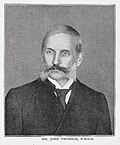English: John Thomson: THIS picture, No. 48, presents to the reader one of the most interesting buildings in the grounds of the Imperial Summer Palace, standing at the foot of Wan-show-shan upon a basis of white marble, and constructed — doors, windows, pillars, roofs, and all — entirely of solid bronze. It is a very perfect example of Chinese temple architecture, showing, as it does, the most minute details of construction, and the skill with which the Chinese can work in metals, and adapt them to almost every use.
The picture is taken with the instrument facing the sun, or against the light, in order thus to obtain for the temple a bold and clear outline, and at the same time to give a soft, and unobtrusive pencilling to the objects of the distant landscape, and by this means heighten the pictorial effect.
During our visit to these Imperial pleasure grounds we put up at the monastery of the Sleeping Buddha, and I was so fortunate as to have for my companion one of the foreign residents, a gentleman well known in Peking, and a native member of the Chinese Civil Service, who was studying the photographic art. The imposing buildings of the monastery, the well-paved courtyards shaded with fine old trees, and adorned with an array of flowering plants in ornamental pots on porcelain stands, the rows of clean cloisters, the kindly disposed abbot and monks, these all contributed to make our visit agreeable as well as interesting. One of the priests told us that the establishment had not been very well supported for some years past. Indeed, the profitable occupation of this body of poor and devout-looking Buddhists all but departed when the Summer Palace was destroyed. They have lands, but not sufficient to support them. They also enjoy a small grant from the Imperial treasury, and they are occasionally called out to attend the marriage or burial ceremonies of members of the Imperial clan. But more marriages, and more funerals, and the more frequent visits of devotees to the shrine of the Sleeping Buddha were much needed to swell the revenues of the establishment. Theirs is a beautiful retreat, nestling in quiet seclusion beneath the brow of a richly wooded hill; and when I gazed upon it I felt as if I should have liked to try a few months of this perfectly retired life— an uneventful, dreamy existence, nourished on the fruits and vegetables of the earth, and almost an incarnation of the vegetable kingdom itself.
The surrounding hills were crowned with buildings of porcelain and marble; one of them, not far from the monastery, and buried in the recesses of a wood which covered the summit of a hill, must have been a princely edifice not many years ago. We reached its ruins along a path cut through a group of rocks wrapped in ivy and fern, and came at last upon a marble basin in one of the inner courts. This was still filled with clear cool water, and teemed with fish. Here, perhaps, the ladies of the establishment beguiled the hours in their dreary days of solitude. The adjoining apartments had once been lofty and imposing, but little of their former magnificence was now to be seen. Ivy had cast a mande of green over the charred and battered walls, creeping in and out of the broken balustrades and wreathing many a marble ornament with its tender leaves.







